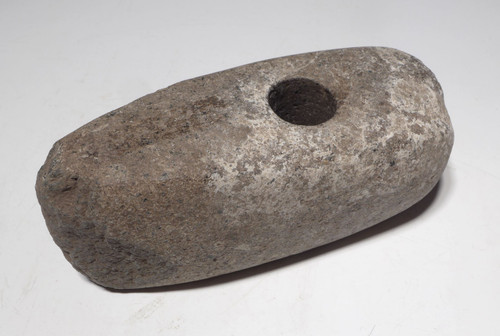Product Description
SEE MORE EUROPEAN NEOLITHIC ARTIFACTS
These THREE ground stone axe bits come from the Neolithic - Chalcolithic Karanovo Culture of the Eastern Balkans. Each has been expertly made of hardstone and skillfully shaped with a knife-edge. These would have been inserted into an antler or bone socket that functioned as a shock absorber, then that assembly inserted into a larger wooden handle shaft. Ground stone tools from the Karanovo Culture of the Balkans are rare prizes of any advanced collection as they are virtually absent on the open market. We acquired only a VERY SMALL group of rare Karanovo Culture items many years ago from an old German collection and once these items are sold, we will never be able to replace them.
HISTORY
The Karanovo culture is a Neolithic - Chalcolithic culture (Karanovo I-III ca. 62nd to 55th centuries BC) named after the Bulgarian village of Karanovo. The culture, which is part of the Danube civilization, is considered the largest and most important of the Azmak River Valley agrarian settlements.
Archaeologists discovered the Karanovo settlement in the 1930s when a tell (a settlement mound) was excavated at Karanovo. The hilltop settlement consists of 18 buildings, which housed some 100 inhabitants. The site was inhabited more or less continuously from the early 7th to the early 2nd millennia BC. The Karanovo culture served as the foundation of the East Balkan cultural sequence. The layers at Karanovo are employed as a chronological system for Balkans prehistory. This culture had seven major phases: Karanovo I and II, which existed parallel to Starčevo; Karanovo III (Veselinovo); Karanovo IV; Karanovo V (Marica); Karanovo VI (Gumelniţa); and, Karanovo VII, which emerged during the Early Bronze Age. Karanovo VI appeared to have collapsed around 4000 BC without any signs of conquest or resettlement.
Some of the main characteristics of the Karanovo culture are the white-painted pottery and dark-painted vessels obtained from the tell. These artifacts were particularly associated with the first and second phases. There is also the case of The Gumelnita Lovers, a terracotta statuette crafted from 5000-4750 BCE. This artifact, which was excavated at the Gumelnita Tell in southern Romania, is associated with the culture's notion of fertility. The Karanovo macroblade technology is also famous, which featured semi-steep and steep retouching as well as the use of yellow flint with white spots. This particular technology, which is also known as "Karanovo blade", emerged during the culture's early Neolithic phase. Scholars note its interesting length and width: 100 mm long and between 15 mm and 23 mm wide.
 US DOLLAR
US DOLLAR
 EURO
EURO
 AUSTRALIAN DOLLAR
AUSTRALIAN DOLLAR
 CANADIAN DOLLAR
CANADIAN DOLLAR
 POUND STERLING
POUND STERLING




















